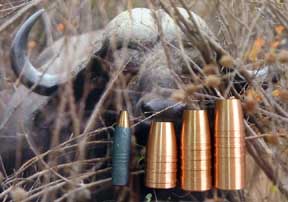

 The Accurate Reloading Forums
The Accurate Reloading Forums  THE ACCURATE RELOADING.COM FORUMS
THE ACCURATE RELOADING.COM FORUMS  Rifles
Rifles  Big Bores
Big Bores  Recoil vs Twist Rate
Recoil vs Twist RateGo  | New  | Find  | Notify  | Tools  | Reply  |  |
| One of Us |
I just read an article on African Hunter Magazine on Greener's 8 bore rifles. It stated he felt that rifling significantly increased the recoil and he would make rifled 8 bores but only smooth bore 4 bores. So my question, does a faster twist rate increase recoil everything else being equal? Will an 11lb 500 NE shooting a 570g bullet at 2150 fps with a 1 in 15" twist recoil less than an 11 lb 500 A2 shooting the same bullet at the same velocity with a 1 in 10" twist rate assuming stock design etc is the same? Thanks! Regards, Chuck "There's a saying in prize fighting, everyone's got a plan until they get hit" Michael Douglas "The Ghost And The Darkness" | ||
|
| one of us |
Greener was noticing the twisting torque of the rifle in hand versus the smoothbore which has none of that twist-generated torque. There is no way that increased rifling twist can increase the rearward free-recoil energy or velocity. Measure it all as impulse. Faster twist will DECREASE the rearward free-recoil imperceptibly. By imparting more rotational kinetic energy/angular momentum to the bullet, the rifle reacts with an equal amount of angular momentum as a twist about the long axis of the barrel. This will be drained off the rearward impulse of the entire rifle. BUT: Look at Saeed's "Champions" videos of 577 T.rex shooters. The reason so many Champions drop the rifle is because it is twisting sideways in their hands. The fact that the rifle stock is not checkered, is smooth, fat, shiney, and probably greased, is a dirty trick. Hard to hold onto a greased pig. Energy and momentum are conserved. Faster twist: LESS linear (rearward) recoil, MORE angular (twisting of rifle about the long axis of barrel) recoil. Perception of the shooter: Smoothbore is easier to hold onto than rifle if the payload is big enough to make a perceptible difference.  | |||
|
| One of Us |
Thanks Rip, my 500 Jeffery with the 1 in 10" twist does twist in your hands from a rest. Shooting offhand I don't notice it at all, though some of my shooting companions have mentioned it. Happy Thanksgiving, Regards, Chuck "There's a saying in prize fighting, everyone's got a plan until they get hit" Michael Douglas "The Ghost And The Darkness" | |||
|
| Moderator |
Assuming a higher MV results in higher Recoil.... AND A faster twist results in a higher pressure and usually higher MV and therefore higher Recoil. Shooting a slug in a smooth bore is lower vel and Recoil than in the same gun with its same weight slug barrel installed. a smooth bore 22 goes slower than a 1:16 at the same gun weight and barrel length It's just math opinions vary band of bubbas and STC hunting Club Words aren't Murder - Political assassination is MURDER Information on Ammoguide about the416AR, 458AR, 470AR, 500AR What is an AR round? Case Drawings 416-458-470AR and 500AR. 476AR, http://www.weaponsmith.com | |||
|
| one of us |
The effects of twist on velocity and pressure have been greatly exaggerated. Artillery testing of twist showed that a 2-fold change in twist rate( 1:7" versus 1:14") caused less than a one-half percent change in velocity (decreased) and a similar negligible change in pressure (increased). The < (1/2)-% change in velocity was in Muzzle Velocity slowing of the faster spinning bullet. No free lunch. The rotational kinetic energy of the bullet spin takes up an insignificant amount of energy, but it takes some muzzle velocity away from the bullet, linear velocity. It all comes from the same powder charge energy content. Less MV, less rearward recoil, but more torque recoil of the rifle with a faster twist. Greener greatly exaggerated the affects of twist on recoil, unless he was talking about torque. A 4-bore would twist in the hands worse than a 577 T.rex.  | |||
|
| One of Us |
Maths aside, the twisting effect is noticable in big bores, and the heavier the bullet the worse it is, so an 8 would be very noticable, and a 4 twice as bad. In my 505 Gibbs firing a 600gn bullet at 2270, if you do not squeeze the grip tight when you touch one off, it will twist out of your hand under recoil. When you are only holding a recoiling big bore by the fore-end the results can be a bit unpredictable, except to say that it is occasionally punnishing! | |||
|
| One of Us |
My 500 Jeffery has a 1 in 10" twist McGowen barrel. It's a sweet barrel but it will twist a bit in your hands. Regards, Chuck "There's a saying in prize fighting, everyone's got a plan until they get hit" Michael Douglas "The Ghost And The Darkness" | |||
|
| Moderator |
of course you can feel twist, especially in some notables ... the hyem 600 NE twists like mad, according to some, but the faster twist 600 OK isn't nearly as bad.. according to more... however, faster twist requires more energy consumed to exist the barrel, assuming same length that energy is brought back to you in recoil... its math, gents opinions vary band of bubbas and STC hunting Club Words aren't Murder - Political assassination is MURDER Information on Ammoguide about the416AR, 458AR, 470AR, 500AR What is an AR round? Case Drawings 416-458-470AR and 500AR. 476AR, http://www.weaponsmith.com | |||
|
| one of us |
Now from the depths of my recollections, something is telling me that Mr. Greener was a leftie. Maybe he got smacked in the face worse than a rightie, with a right-hand twist barrel? Maybe lefties should use left-hand twist barrels on their big bores, if possible. My sympathies to lefties. | |||
|
| one of us |
Twist rate absolutely plays a role in magintude of recoil! ( Source: Gemmerhausen R. Handbook of Weaponry 2nd edition Rheinmetal industries Germany) It's a fundamental principle of gun design. Greener did not assume this based on some calculation or theory but observed this by comparing the behaviour of a smoothbore gun to a rifled gun in a ballistic pendulum. The principle of this observation derives from the physics of recoil which is defined as a gun behaviour to the impulse or time derivative of pressure generated in the gun by the projectile as well as the after effect of the projectile and gas egress from the barrel of the gun ( gas after effect) Pressure resulting in forces acting on the gun system is directly related to to forces of retardation of the projectile in the barrel. The main forces are gas force, projectile resistance force and rifling force. The effect of rifling is quite apparent when comparing the Lagrange curves for guns of varying barrel twist rates. Twist angle is important in calculation of these forces. The higher the angle of twist the greater the force. In calculating the magnitude of total force acting on the gun system this has to be taken into account and is when designing gun recoil systems. Whilst in small bore hand held and shoulder arms the contribution my be small and most often dwarfed by other design considerations the principle still holds that twist angle plays a role in the behaviour we define as recoil. | |||
|
| one of us |
. | |||
|
| one of us |
| |||
|
| one of us |
Alf, Please address torque versus rearward impulse of the gun. . | |||
|
| one of us |
And please try to explain the concepts in lay terms without use of obscure references that are impossible to find on the internet. I am sure you have a nice reference library, but the internet only contains what some human has seen fit to make available there. Twist has minor effects on pressure and muzzle velocity of bullet, on the order of one-half of one percent. Raises pressure and lowers MV minimally. You may put that into your calculus and integrate it over barrel time: No humanly noticeable effects on recoil. Not so with the effects of torque generated by a heavy bullet slamming along the rifling. Most of us will notice that. Frictional force against the bullet is in one direction, and the reaction of the rifling generating that resistance is in the other direction. Right hand rifling twist generates torque to the right. Frictional resistance forces in the bore have the opposite direction to bullet spin, all along the rifling, which makes the rifle react in the same direction as the bullet is spinning. Looking down the bore from breech to muzzle: Right hand twist is clockwise. Bullet will spin clockwise, to right. If bullet spins to right, rifling resistance is a force to the left (vectors left and breechward in direction of rifling lands and grooves). Rifle reaction to the in-bore torque force is equal and opposite. The rifle barrel, which is attached to the rifling, will torque to the right. In fact, the rearward component of that friction vector will also generate an equal and opposite reaction of the rifle, away from the shooter, reducing rearward recoil impulse. But after the bullet is fully engraved, the magnitude of the rearward friction vector is small compared to the leftward frictional force vector, at play until the barrel exits the barrel. Minimal rearward recoil impulse reduction by increased twist rate is thus obtained. Another way of looking at it is to say that the bullet slams into the rifling and pushes the rifling to the right, and the whole barrel follows that. The barrel spins around its long axis, and so does the rest of the rifle, if it is well attached to the rifle. We perceive that as a twisting or torquing of the rifle in hand, away from the face of a right-handed shooter. Into the face of a leftie. W. W. Greener was a leftie. | |||
|
| one of us |
Torque produced by the spin of the projectile is relatively small compared to the torque produced by the unbalance produced by the lack of collinearity between centre of mass of the guns recoiling parts and the linear momentum of the projectile and the jetting gas mass. It is the "explosion of the propellant" that causes the torque force that we see as muzzle or gun jump and not the spin of the projectile. hence the term " Powder couple" used to describe the unbalanced force. If you calculate rotational momentum or rotational energy of the projectile is minuscule compared to linear momentum end energy; what is more the bullet does not sit in the barrel and spin like a top, it makes 2 to 3 full revolutions only and its gone. Though there are the the age old rules of opposite and equal forces and rules of conservation of momentum and energy the gun stays put and the bullet is launched. In a 5 pound 223 rifle the mass of the bullet is but 0.13 % of the total recoiling mass of the gun, It is the bullet that becomes engraved and not the barrel, it is the bullet that is spun and not the barrel. | |||
|
| one of us |
So the rifle is a jet turbine engine generating torque from gas pressure and bullet weight has little to do with it? How about apportioning a torque ratio due to powder gas versus bullet mass? Just a rough idea, but more precise than just "little" for the bullet, please. How about stating how twist generates rearward recoil of the rifle? That concept can be discussed without calculus. Calculus is only needed for precise numerical quantitation, but that too would be appreciated. | |||
|
| one of us |
???? Dont know what you are trying to get at with your last statement? Perhaps less obscure and totally googleable ! Ingalls, yep your very own US born and bred, he stated: The energy of combustion is expended in the following manner: (a) In Kinetic Energy of translation of the projectile. (83%) The rest 17% (b) In Kinetic Energy of translation of the recoiling mass (assuming the recoiling mass free). (c) In the Kinetic Energy of the charge itself. (d) In the work on the rifling and in friction. (e) In the angular energy given to the projectile. (f) In dissipated heat. The last three are very small when compared with (a), (b) and (c). Further (b) and (c) are small as compared with (a). Anyway just thought I would look in and play a bit...... Now I will depart again have yourself a great Christmas etc etc. | |||
|
| One of Us |
Theoretically it all counts in some way and can be accounted for mathematically. However all these elements may not be perceived by the human doing the shooting or may be perceived as insignificant. If it is not perceived who cares? | |||
|
| one of us |
Merry Christmas, Alf. Whatever the magnitude of the torque, it is much less energetic than the rearward impulse of recoil, and it is easily controlled by the familiar shooter who knows how to grip the big bore. Smoothbore: No torque. Rifled bore: Torque. Faster twist rifling: More torque, a lot more with a 577 T.rex shooting 900-grain bullets at plus Mach 2 using only about 160 grains of powder. | |||
|
| One of Us |
A 12 lb rifle is about 93 times the weight of a 900 grain bullet - the amount of torque reaction is directly proportional to the mass of the bullet and the rifle. Plus you add in the weight of any ammo in a magazine and the strength and mass of the hands resisting the motion of the rifle. Most people have more important things to think about.
| |||
|
| one of us |
Torque does not depend on mass alone. It is derived from momentum, the product of mass AND velocity. Yes, the rifle is a lot heavier than the bullet, but the rifle also moves a lot slower than the bullet. That is one reason, among others, that it does not kill on both ends. | |||
|
| One of Us |
Hey Einstein how are you jumping from torque to killing power... So now are you going to give up the secret of killing power? Please tell us what that is and how it it is calculated. They are not the same are they. What causes penetration? Do you have any idea what causes that? When you get back to it now tell me how the torque of the rifle is not directly proportional to the torque of the bullet. Do you really understand that sentence?
| |||
|
| one of us |
Dang but that ignore function sure is nice! Trax and shootaway now have company. | |||
|
| One of Us |
Next to the REPLY and FIND buttons the IGNORE button is my most-used board function. Amazing how it eliminates the rude behavior of others....like magic. . | |||
|
One of Us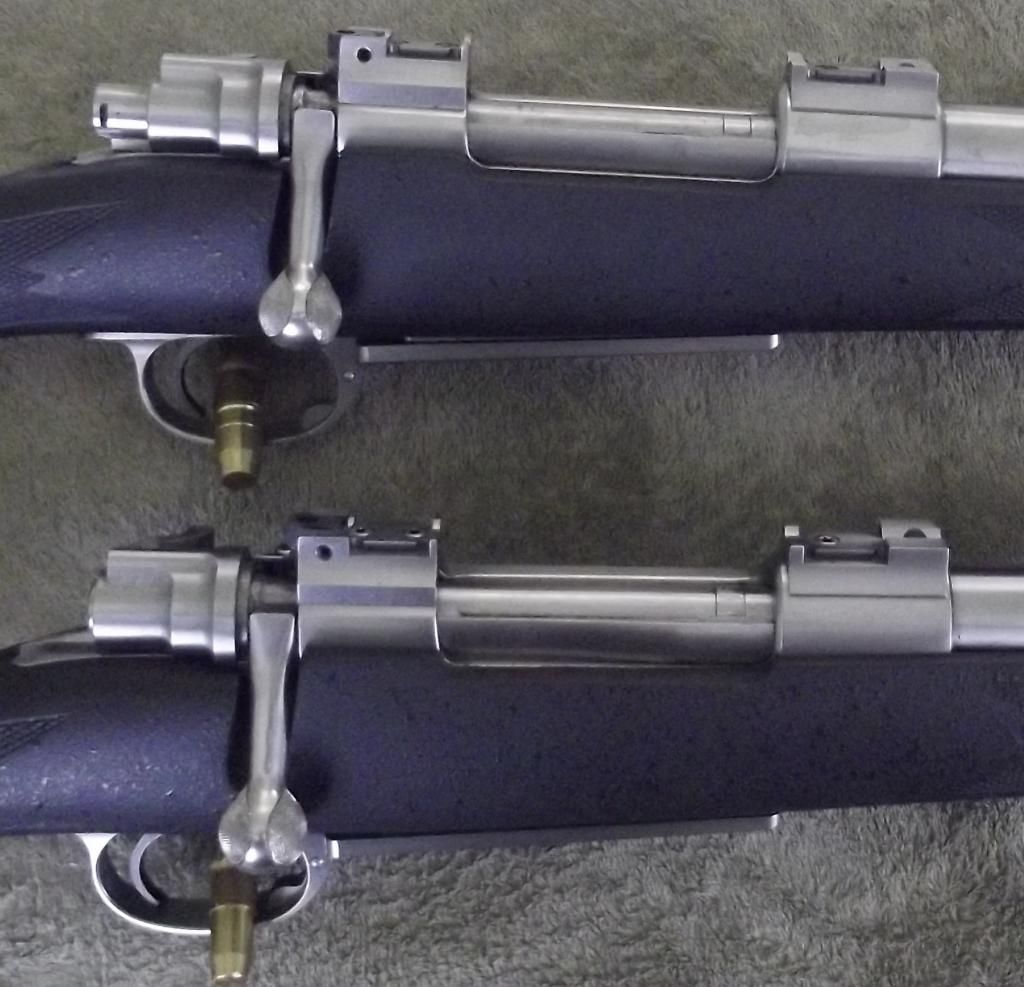 |
Jim "Life's hard; it's harder if you're stupid" John Wayne | |||
|
| one of us |
RIP: I see nothing has changed on AR Anyway back to the problem at hand: Recoil and twist rate : the why and the how ? So we are spinning a bullet, not a point mass object but a bullet with mass located in a form and shape and we are spinning it around a fixed axis. ( spinning top) We are looking now not at simply mass and velocity as a product but rather the effect of the spatial arrangement of multiple mass points in orbit around a fixed axis; we are dealing with the transverse mass moment of inertia of our bullet...... exactly the same parameters at play when that bullet is in flight and when it impacts and penetrates a target. And to those who still cling to the idea that sectional density is a myth or some cooked up entity here it rears its head once more..... mass arranged in a space with shape and form and thus a presenting surface area in direction of motion..... the forces generated by rotating mass in this arrangement are added to the equation. As momentum is a vector we see that the vector direction of angular momentum lies in the same axis as the long axis of spin which in effect is the same as the direction of bullet progression. so this momentum direction is the same as point mass momentum, the quantity however is different but is added to the linear momentum of the bullet...... it has to be because a spinning bullet has more energy than a non spinning bullet. So by spinning the bullet we are adding momentum to the equation and that comes back to bite us in the form of added recoil When designing guns the main forces accounted for in recoil are devided in two major categories. a) the forces accounted for during the combustion of the powder charge and b.) the forces after projectile egression from the bore of the gun ( this is countered by the use of muzzle brakes) The forces associated with recoil are: 1. The gas pressure force or combustion force ie the pressures brought about by the effects of combustion and the inertia of the projectile 2. the effect projectile spin 3. the mass of the recoilling parts of the gun 4. the mass effect of the static or non recoilling part of the gun. 5. the effect of the anchor point of the gun, ie shoulder , platform or carraige. | |||
|
| one of us |
Yes, please go on. | |||
|
| one of us |
RIP: I don't think there is much to add other than to say it may not be a huge issue when shooting our shoulder fired guns.... a few foot pound of recoil added or not perhaps of little consequence. Where is becomes an issue is when we are dealing with large bore guns such as howitzers etc. Now we are not just dealing not just with the recoil of the gun in the axis of projectile motion but the barrel is elevated and the designer has to contend with gun jump in this position. The positioning of recoil damping devices relative to the axis of the bore becomes a consideration, so does gun mount or carriage stability. What is interesting for me is when does the recoil occur in terms of a Time line. If total momentum and energy is equal and opposite then at what point does the recoil motion of the gun start relative to the start of projectile motion in the barrel. is it coincidental or is there a time lapse and how big is this lapse and why? Is the barrel jump already in in motion before the bullet has left the barrel, or is it still in the barrel ? This then adds another dimension to recoil effect. It you hold the gun tightly vs a loose grip on the gun or resting the gun on a rest or bipod how does this effect barrel motion and the position of egress of the bullet? | |||
|
| one of us |
I never noticed torque until I fired a 577 Tyrannosaur. I shot it from the bench with my usual 500 A-Square technique, that had always served to control the rifle. I was very surprised to experience the rifle jumping over onto its right side on the sandbags. Mitch Carter then told me about hooking the thumb of the left hand, off hand for a rightie, over the top of the barrel to control it better. After that, no problem: 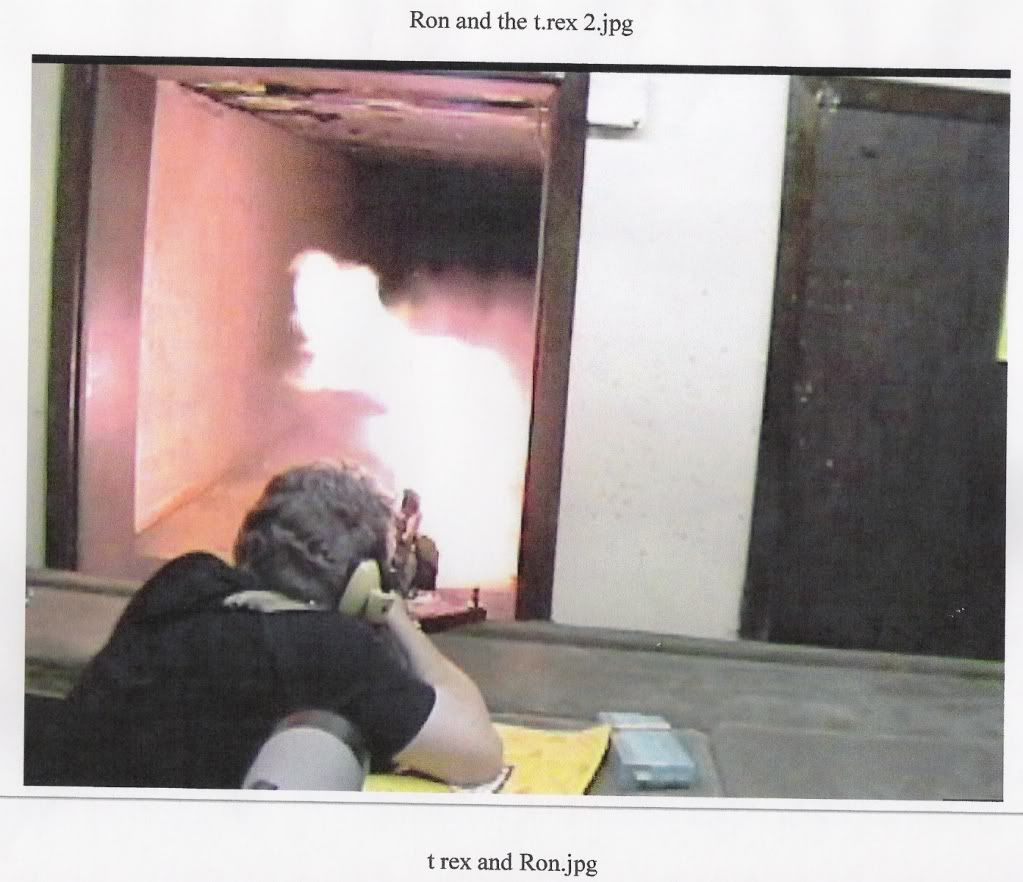 A couple of my 100 yard 3-shot groups: 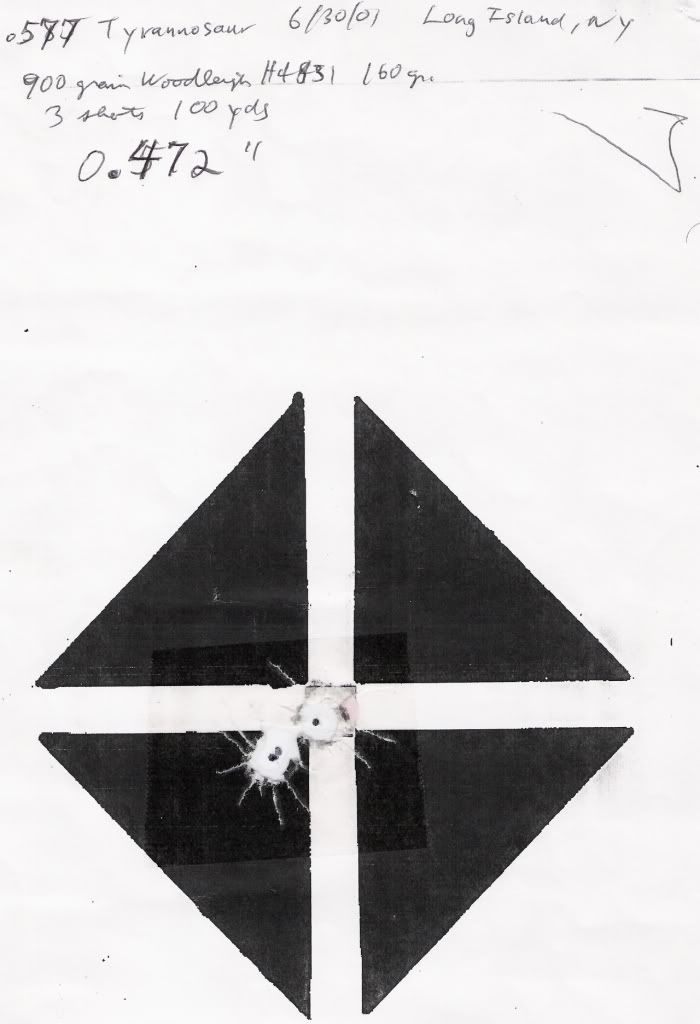 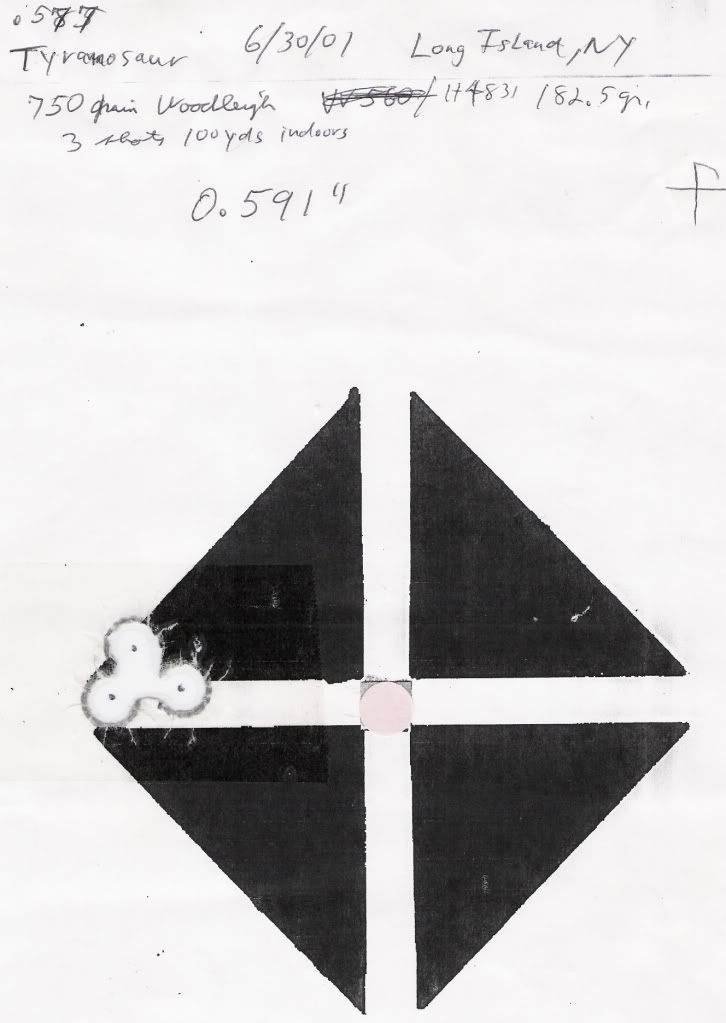 Above rifle had a 1:12", Right Hand twist, just like Saeed's rifle, built by A-Square. Here are Saeed's latest three "Champion" musketeers. They were unaware of the torque, and as usual, all lost hold with the right hand, trigger hand. Two of them kept the spinning rifle inside the left hand. The rifle does spin into the four curled, grasping fingers of the left hand, away from the left thumb laid alongside the forend. The pistol grip of the rifle also spins downward and away from the right thumb laid over the top of it, and tends to break the grip of the more open right four fingers, if the grip is not strong enough. First champion did not even aim, he looked over the top of sights and pointed the rifle at the target, he did not drop the rifle, barely held on, with fingertips of left, off hand. The rightward torquing rifle broke the grip of his trigger hand. What he did better than the other two was only to get the butt low enough to more completely make contact with his shoulder, No heel of butt in the air above his shoulder:   Second champion actually aimed the rifle, but unfortumately had the heel of rifle butt resting against his right earmuff. Earmuffs went skyward. He did not drop the rifle. Lost grip with trigger hand, held on with left. He won this contest if I am judging it:  Earmuffs about a foot above head, on the way up:  Third "Champion" was the loser of this contest: He let the rifle loose.      A leftie would not be as likely to drop the rifle. But he would probably think the recoil worse from getting the rifle torquing and beating into the left side of his face, instead of away from the right side of the face of a righthanded shooter. W. W. Greener was a leftie. Lefties might think about getting custom left hand twist barrels for their big bores. | |||
|
| one of us |
RIP: I understand exactly what you are saying or observing based on these pictures. Intuition certainly would bare this out because one would think that the barrel would react or spin in the opposite direction than the bullet not so. What we do not know about this particular rifle is where it's centre of mass is located relative to the long axis of direction of fire and secondly what effect the point of anchor has on the gun motion. We I look at gun carriage balance physics the phenomenon is termed "torque reaction of the projectile" This directly proportional to the powder reaction on the projectile and then the pitch angle of the rifling. The angle of pitch increases torque for a given pressure. The direction of the reaction of the barrel to this seems to be directly up and back. This then comes down to physics and physical terms. Torque is defined as the rate of change of angular momentum and the direction of angular momentum is coincidental to the axis of fire of the gun. So the effect of spinning the projectile in the barrel adds to the forces in line with the axis of the bore. I have always been amazed at how narrow and high above ground level some old cannon carriages were. The Boers for instance used a battery of cannons mounted on field carriages fondly named the Long Tom. This gun had a very narrow high off the ground carriage and the trunnions were placed high above the ground. These guns did not fall over to one side when fired due to spin. | |||
|
| one of us |
This "enroute to Kimberly" Long Tom?  http://en.wikipedia.org/wiki/155_mm_Creusot_Long_Tom I'll bet if separate truck scales were placed under right and left wheels, when it was fired, the right scales would show more weight than the left scales, if that is a right hand twist barrel. The rifling internally resists the projectile in a direction opposite the direction of motion of a point on the surface of the projectile. The barrel recoil acts in a direction opposite to that internal resistance, so it is in the same direction as the bullet spin. That is how I experienced it. The secret to shooting a 577 Tyrannosaur: Control the spin. Saeed's latest Champions, Three Musketeers above, all had the rifle jumping over to their right side. Right hand twist barrel. | |||
|
| one of us |
| |||
|
| Powered by Social Strata |
| Please Wait. Your request is being processed... |
|
 The Accurate Reloading Forums
The Accurate Reloading Forums  THE ACCURATE RELOADING.COM FORUMS
THE ACCURATE RELOADING.COM FORUMS  Rifles
Rifles  Big Bores
Big Bores  Recoil vs Twist Rate
Recoil vs Twist Rate

Visit our on-line store for AR Memorabilia

